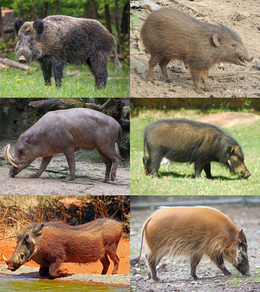
Back Suidae AF Suidae AN خنزيريات Arabic خنزيريات ARZ Suidae AST Wafibol (Suidae) AVK Donuzlar AZ دونوزلار AZB Сусҡалар BA Suidae BAN
| Suidae Temporal range:
| |
|---|---|

| |
| Suid species of different genera; from top-left, clockwise: Wild boar (Sus scrofa), pygmy hog (Porcula salvania), giant forest hog (Hylochoerus meinertzhageni), red river hog (Potamochoerus porcus), common warthog (Phacochoerus africanus), North Sulawesi babirusa (Babyrousa celebensis) | |
| Scientific classification | |
| Domain: | Eukaryota |
| Kingdom: | Animalia |
| Phylum: | Chordata |
| Class: | Mammalia |
| Order: | Artiodactyla |
| Suborder: | Suina |
| Family: | Suidae Gray, 1821 |
| Type genus | |
| Sus Linnaeus, 1758
| |
| Genera | |
|
Over 30 extinct genera, 6 extant, | |
Suidae is a family of artiodactyl mammals which are commonly called pigs, hogs or swine. In addition to numerous fossil species, 18 extant species are currently recognized (or 19 counting domestic pigs and wild boars separately), classified into between four and eight genera. Within this family, the genus Sus includes the domestic pig, Sus scrofa domesticus or Sus domesticus, and many species of wild pig from Europe to the Pacific. Other genera include babirusas and warthogs. All suids, or swine, are native to the Old World, ranging from Asia to Europe and Africa.
The earliest fossil suids date from the Oligocene epoch in Asia, and their descendants reached Europe during the Miocene.[1] Several fossil species are known and show adaptations to a wide range of different diets, from strict herbivory to possible carrion-eating (in Tetraconodontinae).[2]
- ^ Palmer, D., ed. (1999). The Marshall Illustrated Encyclopedia of Dinosaurs and Prehistoric Animals. London: Marshall Editions. p. 269. ISBN 1-84028-152-9.
- ^ Savage, R. J. G.; Long, M. R. (1986). Mammal Evolution: an illustrated guide. New York: Facts on File. pp. 212–213. ISBN 0-8160-1194-X.